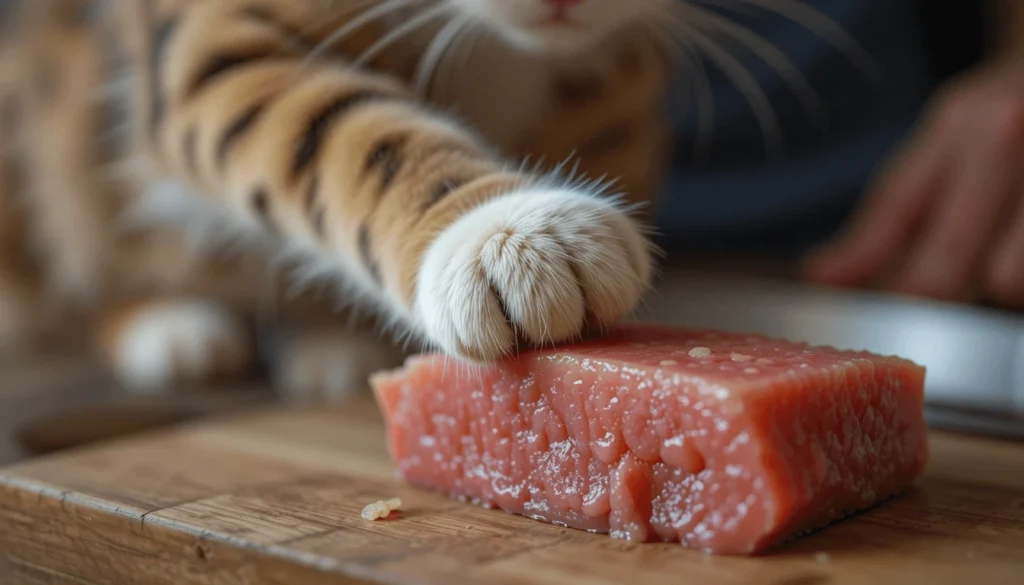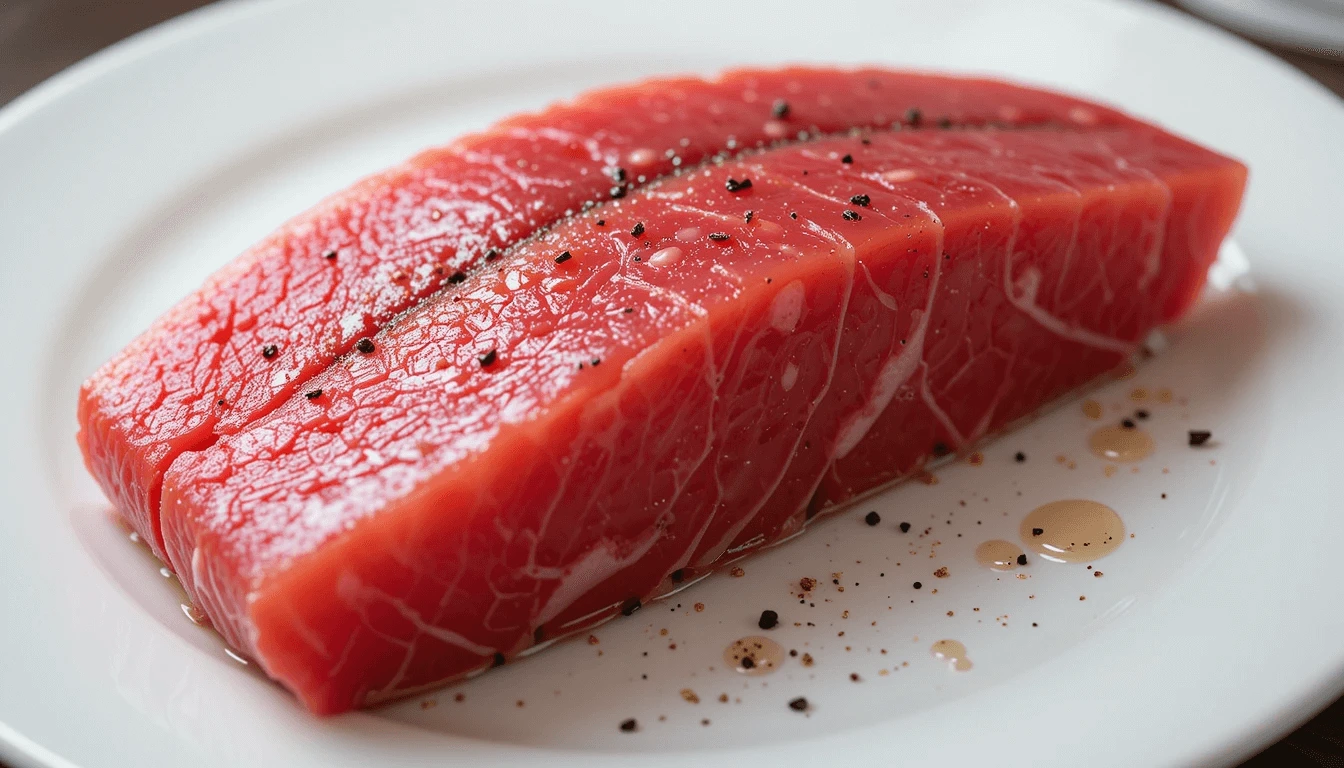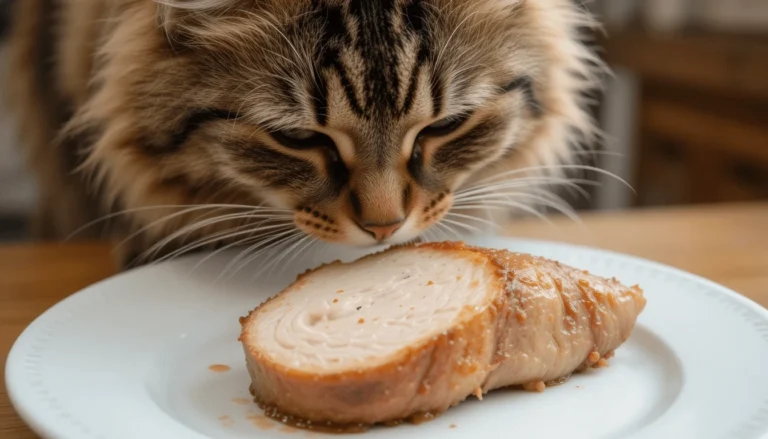Can Cats Eat tuna? Risks, Toxicity, and Safe Alternatives
Introduction
Whiskers perks up every time I open a can of tuna—her eager meows are hard to resist! But as I drizzle the fishy juice over her bowl, I wonder: ‘Can cats eat tuna safely, or am I unknowingly harming her?’ Turns out, this feline favorite hides risks like mercury poisoning and nutrient imbalances. Let’s dive into the truth behind tuna for cats, backed by vet insights.
The Hidden Dangers of Feeding Tuna to Cats
Mercury Poisoning: A Silent Threat
Tuna, especially larger species like albacore and bluefin, sit high on the aquatic food chain. This means they accumulate significant amounts of methylmercury—a potent neurotoxin—in their flesh over their lifespan.
According to a FDA study on commercial fish mercury levels, albacore tuna contains nearly three times more mercury than smaller skipjack tuna. For cats, whose bodies are much smaller than humans, even small amounts can become dangerous over time.
Symptoms of mercury poisoning in cats may include:
- Loss of coordination (ataxia)
- Muscle tremors or twitching
- Abnormal behavior like increased aggression or lethargy
- Vision problems
What makes mercury particularly concerning is its bioaccumulative nature—it builds up in your cat’s system faster than their body can eliminate it. This means occasional tuna treats could lead to toxic levels over months or years.
Thiamine Deficiency: The Vitamin B1 Crisis
Raw tuna contains an enzyme called thiaminase, which actively breaks down thiamine (vitamin B1). This is particularly problematic because:
- Cats cannot synthesize thiamine on their own
- Because thiamine dissolves in water, cats can’t build up significant stores of this essential nutrient in their bodies.
- Commercial cat foods are fortified with extra thiamine to prevent deficiencies
A thiamine deficiency can cause severe neurological damage, with symptoms like:
- Seizures or convulsions
- Circling or head tilting (vestibular signs)
- Loss of appetite leading to hepatic lipidosis
- Dilated pupils and vision impairment
While cooking reduces thiaminase activity, it doesn’t eliminate it completely. This means even cooked tuna given regularly could contribute to thiamine depletion over time.

The Tuna Addiction Problem
Many cat owners discover—too late—that their feline has developed a strong preference for tuna, refusing to eat anything else. This creates several issues:
Nutritional Imbalances:
Tuna fails to provide key nutritional components that felines require, such as:
- Adequate taurine (critical for heart and eye health)
- Proper calcium:phosphorus ratios (important for bone health)
- Vitamin E deficiency can result in a condition known as steatitis or yellow fat disease.
Behavioral Challenges:
Cats that hold out for tuna may:
- Go on hunger strikes when offered normal food
- Develop food aversion to healthier options
- Become aggressive around mealtimes
Digestive Upsets:
The high oil content in some tuna preparations can lead to:
- Pancreatitis (inflammation of the pancreas)
- Diarrhea or vomiting
- Obesity from excess calories
How to Safely Offer Tuna (If You Choose To)
The Occasional Treat Rule
If you decide to give tuna, follow these strict guidelines:
Frequency:
- Absolute maximum: 1-2 times per month
- Serving size: No more than 1 teaspoon per 10 lbs of body weight
Preparation Methods:
- Best option: Water-packed, no-salt-added canned tuna
- Drain thoroughly to remove excess oils/salt
- Never feed raw tuna due to thiaminase and bacteria risks
- Avoid oil-packed varieties (too high in fat)
Mixing Strategy:
Blend a tiny amount with regular food to:
- Add flavor to encourage eating
- Prevent tuna fixation by keeping it as a minor component

Choosing Safer Tuna Varieties
Not all tuna carries equal risk. Follow these selection tips:
Lowest-Mercury Choices:
| Tuna Type | Mercury Level | Safety Rating |
|---|---|---|
| Skipjack | Low | ★★★★☆ |
| Canned Light | Low-Moderate | ★★★☆☆ |
| Albacore | High | ★★☆☆☆ |
| Bigeye/Bluefin | Very High | ★☆☆☆☆ |
Special Considerations:
- Look for dolphin-safe labels to ensure ethical sourcing
- Wild-caught generally has lower contaminant levels than farmed
- Check for BPA-free cans to avoid chemical leaching
Creating Balanced Tuna Meals
If using tuna as a food topper or treat, balance it with:
Essential Additions:
- A pinch of taurine powder (available at pet stores)
- Calcium supplement to offset phosphorus levels
- Pierce a vitamin E capsule and add just a drop of its contents”
Sample Balanced “Tuna Treat” Recipe:
- 1 tsp drained skipjack tuna
- 1/8 tsp taurine powder
- 1/4 tsp plain, cooked pumpkin (for fiber)
- Mix with 1/4 cup of regular cat food
Healthier Alternatives to Tuna
Commercial Fish-Based Cat Foods
Reputable brands formulate fish-flavored foods with:
- Added taurine and vitamins
- Controlled mercury levels
- Balanced omega-3 to omega-6 ratios
Top Vet-Recommended Brands:
- Hill’s Science Diet Ocean Fish
- Royal Canin Digest Sensitive Loaf in Sauce
- Purina Pro Plan Focus Urinary Tract Health
Safer Fresh Fish Options
These provide omega-3s without high mercury:
Best Choices:
- Cooked salmon (boneless, skinless, no seasoning)
- Sardines packed in water (low on food chain)
- Cooked whitefish like cod or haddock
Preparation Tips:
- Always remove all bones to prevent choking
- Steam or bake without oils/salt
- Limit to 1-2 small bites per week
Fish-Flavored Supplements
For cats that love fish taste without risks:
Healthy Alternatives:
- Omega-3 supplements (fish oil capsules designed for cats)
- Freeze-dried minnows or anchovies as treats
- Fish broth ice cubes (homemade, no onions/garlic)
Conclusion
While tuna might seem like a harmless treat for your feline friend, the reality is more complex. Occasional, carefully prepared tuna in tiny amounts may be safe for some cats, but the risks of mercury poisoning, thiamine deficiency, and nutritional imbalances make it a poor dietary staple. Instead, opt for vet-approved commercial cat foods with fish or safer alternatives like cooked salmon and sardines.
Remember, every cat is different—what works for one may harm another. Always consult your veterinarian before introducing new foods, especially if your cat has health conditions like kidney disease or allergies.
So the next time your cat stares longingly at your tuna sandwich, ask yourself: Is this momentary indulgence worth potential long-term health consequences?
Additional Resources:
FAQs
Can cats eat canned tuna in water?
Yes, but only in strict moderation. Choose no-salt-added, water-packed tuna and limit it to a teaspoon once or twice a month. Avoid feeding it regularly due to mercury and thiamine risks.
Why is tuna bad for cats long-term?
Tuna lacks essential nutrients like taurine, vitamin E, and calcium, which are crucial for feline health. Over time, a tuna-heavy diet can lead to:
- Heart disease (from taurine deficiency)
- Neurological issues (from thiamine deficiency)
- Mercury poisoning (from bioaccumulation)
What are the first signs of mercury poisoning in cats?
Watch for:
- Loss of coordination (stumbling, falling)
- Muscle tremors (especially in the face or limbs)
- Behavioral changes (lethargy or sudden aggression)
If you notice these, contact your vet immediately.
Is tuna juice safe for cats?
A few drops of tuna juice (from water-packed, no-salt-added cans) can be used to entice picky eaters. However, don’t make it a habit—even the juice contains traces of mercury.
What fish is safest for cats?
Cooked salmon, sardines, or whitefish (like cod) are better options—they’re lower in mercury and can be part of a balanced diet when given occasionally.







